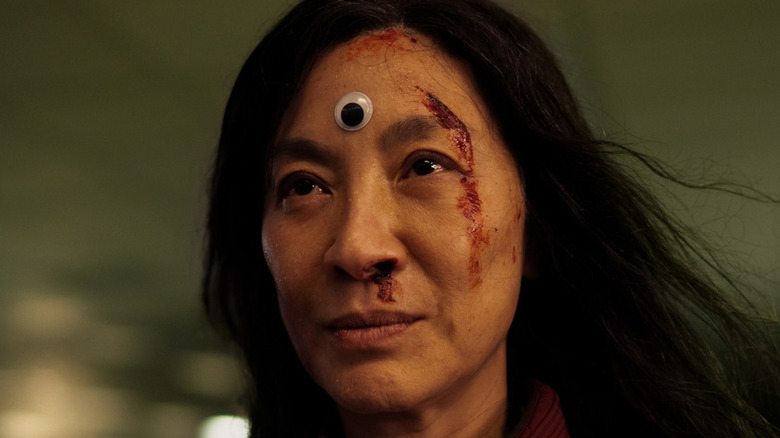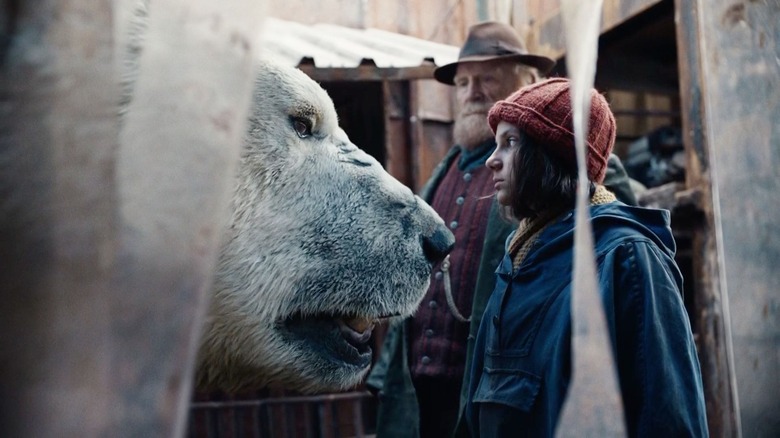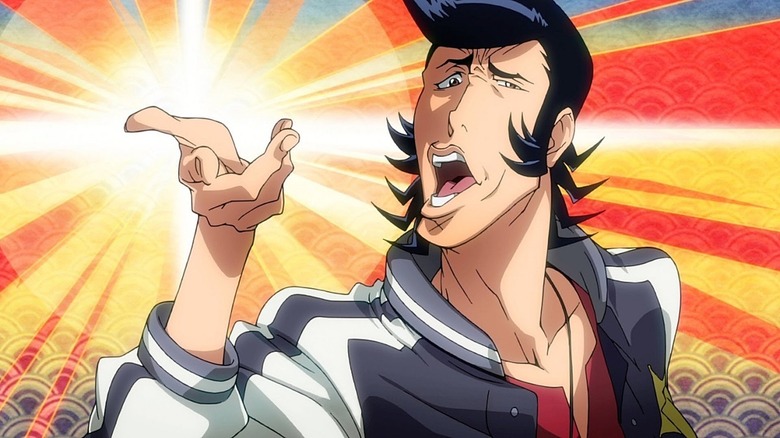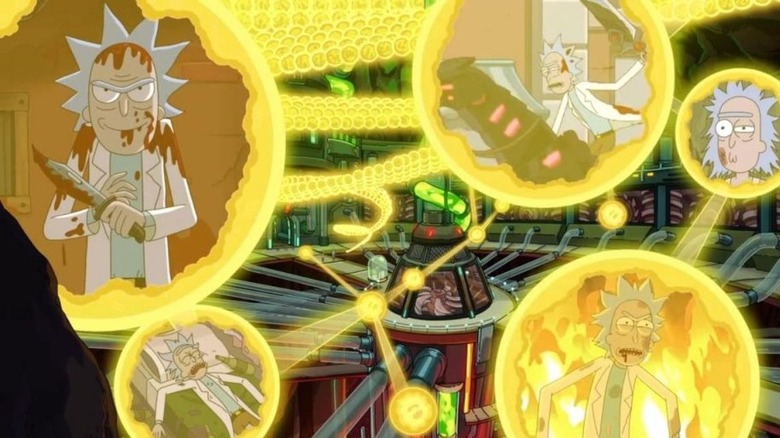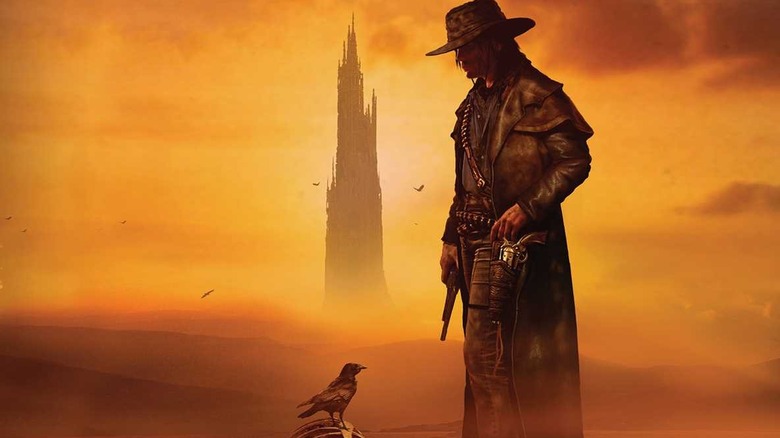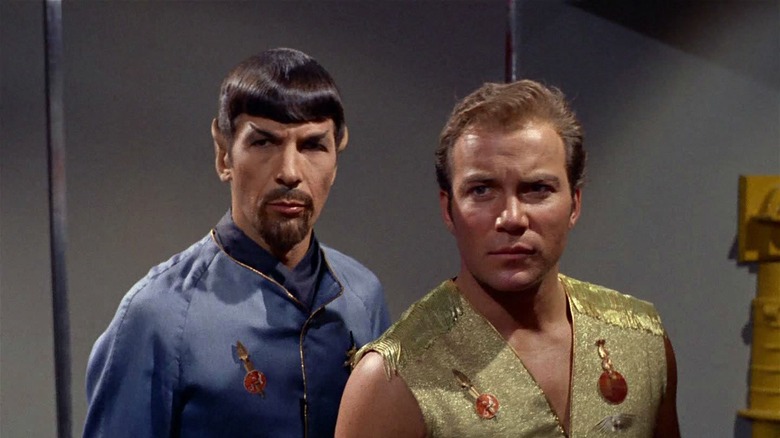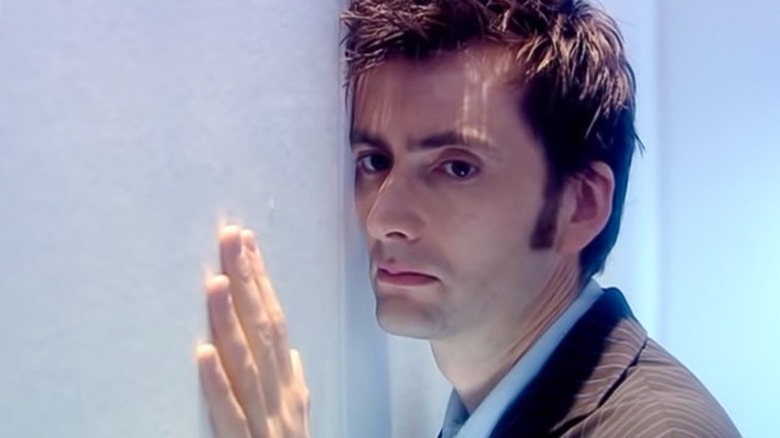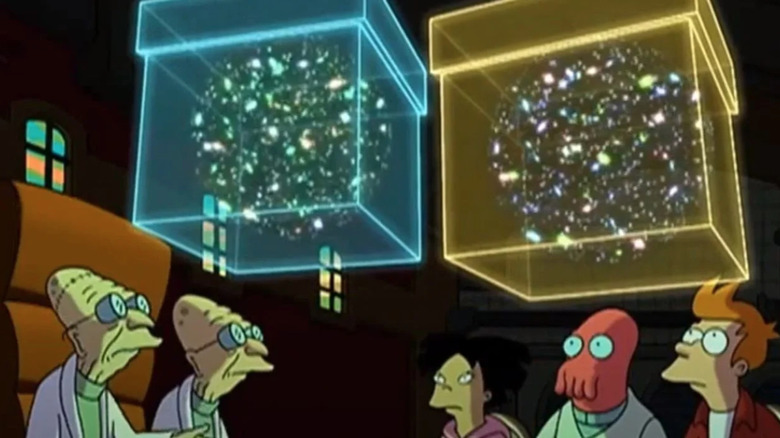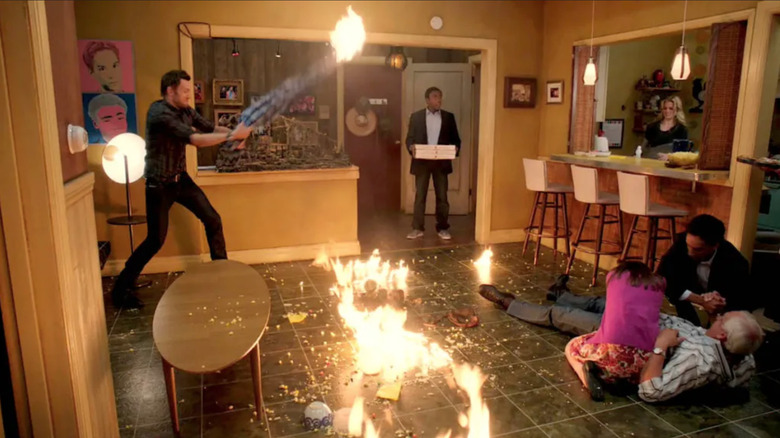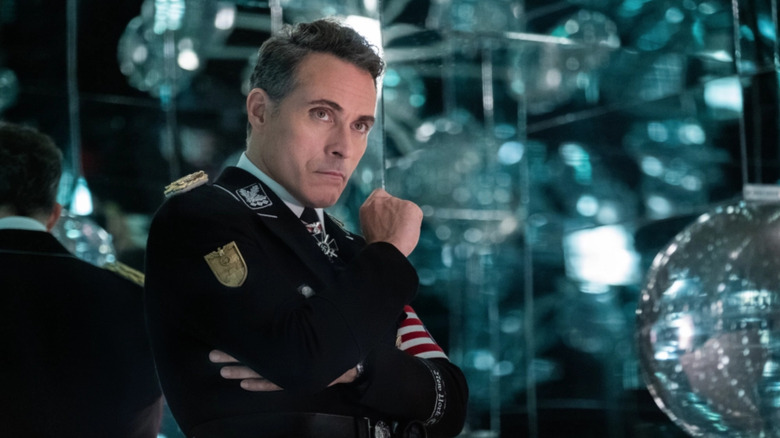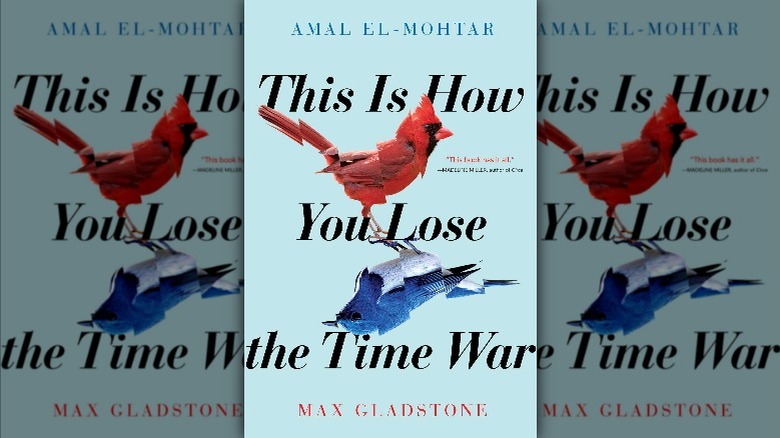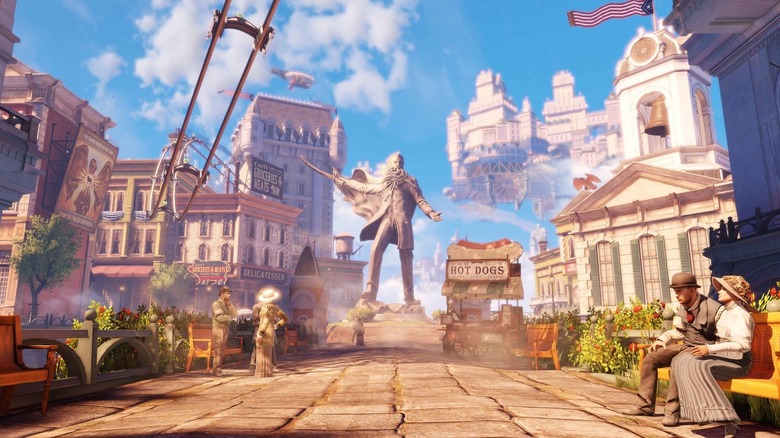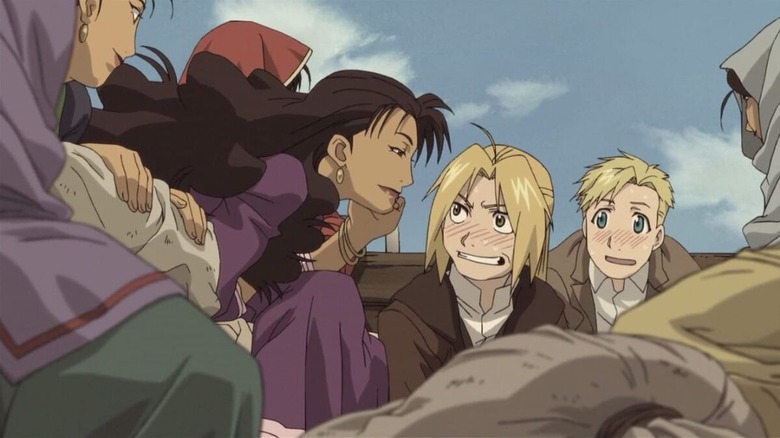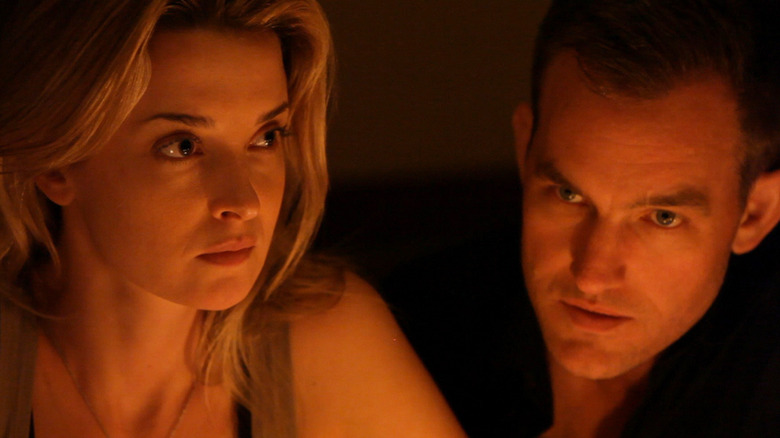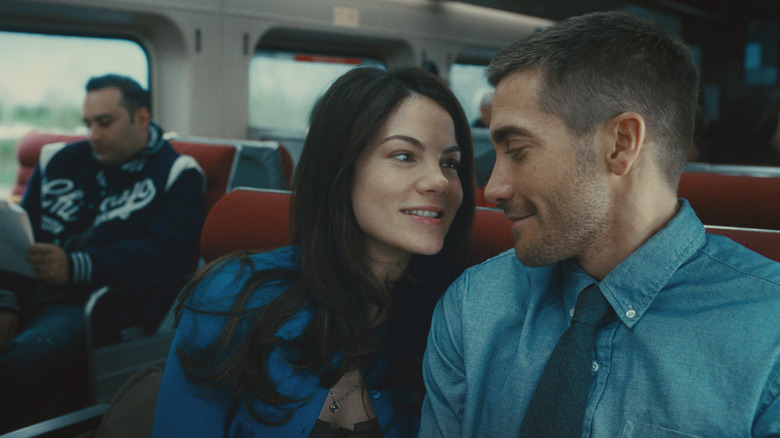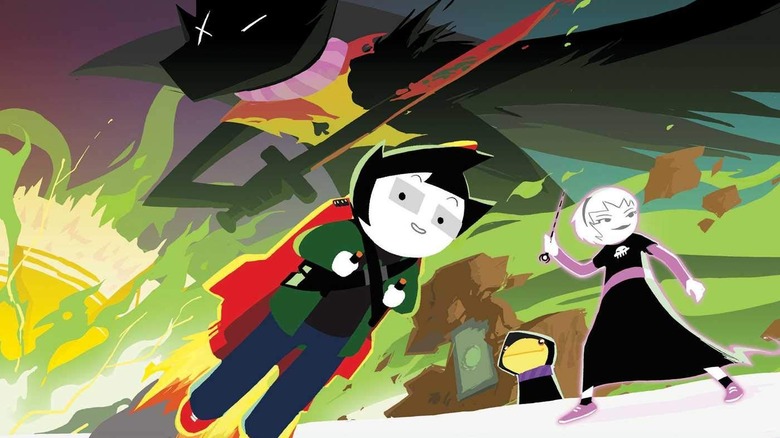The Best Multiverse Stories Not From DC Or Marvel
The multiverse has hit the mainstream, in large part due to DC and Marvel superhero comic adaptations starting to delve into the multiple worlds of their original source material. "Spider-Man: Into the Spider-Verse" won massive critical acclaim and the best animated feature Oscar, and the live-action Marvel Cinematic Universe followed suit in multiverse-themed Phase 4 releases like "Loki," "Spider-Man: No Way Home," and "Doctor Strange in the Multiverse of Madness." DC's Arrowverse TV shows received a multiversal crossover in 2019's "Crisis on Infinite Earths" event (inspired by the classic 1985 comics event of the same name), and 2023's "The Flash" promises a similar event for DC's movie universes.
As much attention as the DC and Marvel multiverses receive, however, they are far from the only ones worth watching. Parallel worlds have long been a staple of science fiction, with many writers finding creative ways to build stories off the infinite possibilities of multiversal theory. Here are some of the best stories about traveling between different universes outside of DC and Marvel.
His Dark Materials
Philip Pullman's "His Dark Materials" trilogy is among the most sophisticated and controversial works of children's literature. The first book, "The Golden Compass," is the most straightforward: it's an adventure story set in a world where human souls take physical form as animal-shaped dæmons. The second book, "The Subtle Knife," finds the young heroine Lyra traveling to other universes, including our own. The final book, "The Amber Spyglass," gets even more ambitious, introducing even stranger worlds and presenting a full-on multiversal war over the fate of Heaven.
Hollywood attempted to adapt the series to film with 2007's "The Golden Compass." That adaptation, which significantly toned down the source material's critique of organized religion in a failed attempt to avoid controversy, received mixed reviews and bombed at the American box office, killing any chance of sequels. However, the BBC and HBO eventually collaborated on a fuller, more faithful TV adaptation beginning in 2019 (with the final season scheduled to air in late 2022).
Pullman himself has returned to Lyra's world for a new trilogy, "The Book of Dust." Two volumes have been published as of this writing — the "His Dark Materials" prequel "La Belle Sauvage" and the sequel "The Secret Commonwealth" — though neither of these contain any crossover with the other universes from the original trilogy.
Space Dandy
As the show's opening sequence puts it, "Space Dandy is a dandy guy in space." This 2014 anime series marked director Shinichiro Watanabe's return to the science-fiction genre, though those expecting something similar to his breakout hit "Cowboy Bebop" were in for a surprise. While both "Cowboy Bebop" and "Space Dandy" do follow the episodic adventures of space-faring bounty hunters, "Dandy" goes for pure comedy, with a cast of dim-witted characters who frequently end up dead by the end of the episode.
That regular dying is where the multiverse comes in. Each episode of "Space Dandy" takes place in a different universe, not only negating the need for continuity, but also allowing the show's writers and directors to experiment with a wide variety of styles. The developing revelations about Dandy's own special place in the multiverse allows this extremely silly show to get philosophical — and, in a few episodes, even moving — all without sacrificing its delightfully carefree attitude.
Everything Everywhere All at Once
The big sleeper hit of spring 2022, "Everything Everywhere All at Once" might be the movie to most extensively explore the infinite possibilities of the multiverse. Michelle Yeoh stars as Evelyn, a woman who's failed at basically everything she's set out to do — but throughout the multiverse, all her failures have turned out differently. She's a martial arts movie star in one world, a master chef in another, and "Evelyn Prime" happens to be the genius scientist who discovered how to travel between universes — while also unleashing a threat that could destroy all of them.
Directed by the Daniels, the duo behind "Swiss Army Man," and produced by the Russo brothers of "Avengers: Endgame" fame, "Everything Everywhere All at Once" uses absurdist comedy, inventive action, and verse-jumping sensory overload to tell the emotional story of a woman reconnecting with her husband and daughter. It uses the multiverse as a means to examine nihilism from both negative and positive angles, presenting a symbolistic duality of the everything bagel of despair and the googly eyes of creating your own meaning.
Rick and Morty
Speaking of multiverse stories about nihilism, one cannot overlook both the cultural impact and sheer creativity of "Rick and Morty." Dan Harmon and Justin Roiland's popular Adult Swim cartoon about a mad scientist and his grandson first introduced multiversal travel in its sixth episode, "Rick Potion No. 9," in which Rick and Morty travel to another universe where they kill and replace their alternate selves after accidentally turning their home-universe into Cronenberg monsters. Since then, the series' vast multiverse has only grown more complex and entertainingly ridiculous.
From interdimensional cable TV shows to whole cities comprised of alternate Ricks and Mortys, the "Rick and Morty" multiverse is both a source of humor and a tool for storytelling. Similar to Jobu Tupaki in "Everything Everywhere All at Once," seeing so many different worlds offers an explanation for Rick's cynical outlook on life. The Season 5 finale, "Rickmurai Jack," only made the multiverse mythology even more complex, expanding beyond the "Finite Central Curve" and introducing new universes where Rick isn't the smartest man in existence.
Notably, Emmy-winning "Rick and Morty" writer Michael Waldron went on to write the scripts for both "Loki" and "Doctor Strange in the Multiverse of Madness." This original multiverse has, in its own way, contributed to the quality of the superhero multiverse movie boom.
The Dark Tower/Stephen King
Perhaps the most popular literary multiverse outside of superhero comics is one that many readers might not even realize is a multiverse. All the books of beloved horror author Stephen King canonically exist within the same multiverse. The connections between these books' different universes were revealed within his eight-book "The Dark Tower" fantasy series.
The Dark Tower is the nexus point of all universes, and the series that shares its name follows the gunslinger Roland Deschain on his quest to find the tower and save his dying world. Written over the course of 30 years, the series is a long (and, at times, messy) read — one even some big King fans have found intimidating. Those who stick with it, however, will be rewarded with both an ambitious genre-blending epic and fascinating connections to the worlds of King's other books ... But feel free to skip the 2017 movie adaptation, as it was widely hated by fans and critics alike.
Star Trek
Long before superhero cinematic universes, much less multiverses, were even a thing, the primary cultural association with parallel universes was the "Mirror Universe" from "Star Trek." It first appeared in the original series Season 2 episode "Mirror, Mirror," wherein the regular versions of Kirk, Uhura, Scotty, and McCoy accidentally switched places with their Mirror Universe versions. Where the Enterprise crew in the main "Star Trek" universe is optimistic and idealistic, their Mirror Universe versions are violent and militaristic.
The goatee on Mirror Universe Spock may be silly, but it's iconic enough to become one of pop culture's go-to signifiers of an evil doppelgänger. Subsequent "Star Trek" series, including "Star Trek: Deep Space Nine" and "Star Trek: Discovery," have returned to the Mirror Universe and explored its workings in greater depth. The Kelvin Timeline in which the J.J. Abrams-directed 2009 movie and its sequels take place in is yet another significant alternate universe in the "Star Trek" multiverse.
Doctor Who
In a sense, any time travel story that involves changing history could technically be considered a multiverse story, but the phrases "time travel" and "multiverse" bring about different associations. The long-running BBC series "Doctor Who" makes this list not because of its "wibbly-wobbly timey-wimey" mess of fluid history, but because certain memorable stories directly involve universes outside of the Doctor's own.
In the original run of the show, storylines such as "Inferno" featured the Doctor traveling "sideways" through time into another timeline, rather than forward and backward in his own timeline. In Season 2 of the 2005 revival, the 10th Doctor and his companions Rose and Mickey face the Cybermen in a parallel universe. The Cybermen eventually find a way to travel between universes, and defeating them ultimately separates the Doctor and Rose in different worlds. Other parallel universes exist in bubbles displaced from time; the Doctor's home planet of Gallifrey was moved into one such pocket dimension during the Time War.
Futurama
In the "Futurama" Season 3 episode "I Dated a Robot," Professor Farnsworth claims there are only two parallel universes: the one that the show primarily takes place in and another one visible across a gap from the edge of the main universe. So how does "Futurama" get away with introducing dozens of additional universes in the following season's "The Farnsworth Parabox"? The DVD commentary explains that while there's only one parallel universe, there are multiple perpendicular universes.
In a clear homage to the "Star Trek" Mirror Universe, "The Farnsworth Parabox" features different versions of the Planet Express crew arguing over whose universe is the "evil" one. The "Futurama" movies introduced more alternate universes, including the domain of the ancient monster Yivo in "The Beast With a Billion Backs" and the Bender-created fantasy realm of Cornwood in "Bender's Game. The episode "The Late Philip J. Fry" involved resetting the main universe twice, so Fry, Bender, and Farnsworth have also lived through three slightly different versions of their own universe.
Community
"Community" was an incredibly quirky sitcom, but for the most part, it was at least somewhat grounded in reality. The Season 3 episode "Remedial Chaos Theory," however, was grounded in multiple realities, resulting in an episode far enough into the science fiction realm to be nominated for a Hugo Award. Series creator Dan Harmon would take this multiverse creativity to further extremes with "Rick and Morty," while co-writer Chris McKenna would later work on "Spider-Man: No Way Home."
"Remedial Chaos Theory" presents seven alternate timelines, each based on which of the seven study group members will leave to pick up a pizza. Most memorable among these different realities is the one where Troy Barnes leaves, resulting in the chaotic "Darkest Timeline" (and one of the best reaction GIFs of all time). Abed Nadir's imagination would be preoccupied by this "Darkest Timeline" throughout future episodes of "Community" — though none of the later episodes with this focus could match up to the brilliance of "Remedial Chaos Theory."
The Man in the High Castle
Philip K. Dick's Hugo Award-winning 1962 alternate history novel "The Man in the High Castle" imagines a world wherein the Axis Powers won World War II. Imperial Japan controls Asia, Nazi Germany controls Europe, and the two global superpowers split control over what was once the United States. Much of the plot centers around a book-within-a-book, "The Grasshopper Lies Heavy," which imagines an alternate universe where the Allies won the war but history plays out differently from our own universe. In one of the most surreal scenes, one character enters a trance which transports him into another universe that's implied to be our own.
The Dick novel became the basis for an Amazon Prime Video series of the same name, which ran for four seasons from 2015-2019. The streaming show changed and expanded the story significantly from the relatively short novel, and with it, expanded its multiverse. The titular "Man in the High Castle" is no longer just the writer of alternate history novels but someone who collects films from other universes. Interdimensional travel occurs more frequently, and the Nazis attempt to weaponize this ability to expand their empire into other worlds.
This Is How You Lose the Time War
Winner of the Hugo and Nebula awards for best novella, "This Is How You Lose the Time War" is a quick yet complex read that comes highly recommended to fans of literary science fiction. It's presented as a series of letters between Red, a soldier fighting the time war on behalf of technologically-based empire, and Blue, fighting for the opposing biological empire. Amal El-Mohtar wrote Blue's letters, while Max Gladstone wrote Red's.
The story arc is essentially an enemies-to-lovers romance, building across multiple timelines and concluding with some ingenious twists. The mechanics of the time war itself are deliberately confusing; this is more about the emotional journey than understanding the multiverse itself. Red and Blue have seen so many universes come and go that they have no compunctions about killing — but when one has to kill the other, things become a lot more difficult.
BioShock Infinite
The 2013 video game "BioShock Infinite" is not a sequel to the first two "BioShock" games, but rather an alternate reality dealing in similar themes and similarly stunning aesthetics. As opposed to the underwater 1950s libertarian dystopia of Rapture, "BioShock Infinite" is set in the airborne city of Columbia in the 1910s, ruled by an ultra-nationalist dictator. Gamers play as Booker DeWitt, a man visiting Columbia on a mission to rescue Elizabeth, a woman with the America Chavez-like power to tear through the space-time continuum.
The increasingly complicated story of "BioShock Infinite" involves traveling through multiple realities (including, for part of the ending and a DLC expansion, that of the original "BioShock"). The game's political commentary unfortunately isn't as sharp as its grasp on quantum physics, with one mid-game twist drawing unfortunate false equivalencies between Columbia's oppressed and their oppressors. Despite its problematic elements, however, there's still a lot to admire about the game's world-building.
Fullmetal Alchemist 2003
The 2003 "Fullmetal Alchemist" anime TV series is unfortunately out of print and unavailable to stream at the moment (its follow-up movie, "Fullmetal Alchemist: The Conqueror of Shamballa," is streaming but makes no sense without seeing the show first). The 2009 remake "Fullmetal Alchemist: Brotherhood," which more faithfully adapts Hiromu Arakawa's original manga, has all but displaced it amongst anime fans. For all of the controversy around the 2003 version's changes, however, its alternate storyline is compelling in its own right — and makes strong use of parallel universes.
Essentially, "FMA" 2003 makes the subtext of the series' world-building into explicit text: that Amestris is a direct alternate-reality version of our universe's Germany in the early 20th century. In this version of the story, The Gate is a gateway between universes, and the TV series ends with Edward pulled through The Gate as part of his sacrifice to save his brother Alphonse. "Conqueror of Shamballa" centers around Edward's quest to return to his homework and reunite with his brother, all while facing the threatening rise of the Nazis.
Coherence
Making a good multiverse movie doesn't require a blockbuster budget. The 2013 indie film "Coherence" proves it's possible to make a good multiverse with barely a budget at all. The total cost of the production is estimated to be just $50,000. Directed by James Ward Byrkit, a regular collaborator of "Pirates of the Caribbean" director Gore Verbinski, "Coherence" was filmed in sequence over five days with mostly improvised dialogue and the actors deliberately kept in the dark about the other characters' secrets (via IndieWire).
The story starts off at a dinner party while a comet is passing. Suddenly, there's a power outage, and things are immediately different. To say any more about what happens next would constitute spoilers (honestly, even including it on this list could arguably be considered a "spoiler" by some). The result is a heady sci-fi thriller that doesn't need special effects in order to blow viewers' minds.
Source Code
Similar to more traditional time travel movies, the time loop sub-genre also inherently interacts with the scientific concepts behind multiverse theory. Whereas the likes of "Groundhog Day" and "Russian Doll" don't really focus on the mechanics of their time loop plot devices, Duncan Jones' 2011 genre entry "Source Code" is very directly concerned with the workings of its time loop and what it means for the nature of reality — or should that be realities plural?
Jake Gyllenhaal plays Captain Colter Stevens, a soldier inhabiting another man's body and trying to stop a terrorist attack on a train. He fails repeatedly and is sent back again and again in the "Source Code" to try and stop the attack. The exact nature of what the Source Code is doing and why Captain Stevens is the one who has to use it are mysteries with dark, strange, and ultimately satisfying answers.
Homestuck
"Let me tell you about 'Homestuck.'" For those who were in certain circles of the internet in the early 2010s, this phrase will inspire either nostalgia, embarrassment, or dread. "Homestuck" was a hybrid webcomic, with bits of animation, music, and interactive game segments mixed in, created by Andrew Hussie as part of the "MS Paint Adventures" website.
Summarizing the story is no easy task, but essentially, "Homestuck" is about a group of kids playing a reality-altering video game where the end goal is the create a new universe. This journey involves several apocalypses, time paradoxes, and collaboration with an alien species known as trolls (their personalities modeled after different archetypes of internet trolls).
Published between 2009 and 2016, the original run of "Homestuck" exploded in popularity, with cosplayers crowding conventions, major updates overloading servers, and a Kickstarter for a video game prequel raising over two million dollars. Said video game, "Hiveswap," was unfortunately beset by a troubled production (as of this writing, only two of the four proposed episodes of the game have been released). A "Homestuck^2: Beyond Canon" sequel comic began in 2019 but has been on hiatus since 2020.
